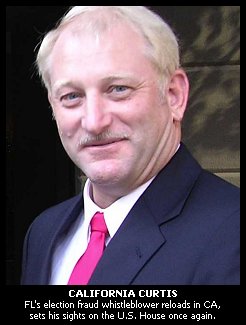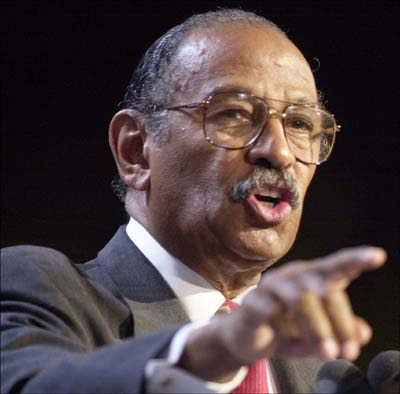Revisiting the 2004 election, part 10–Florida
Today there are still gaps in federal regulatory authority and oversight of the voting technology industry. Not surprising, when you look at the standard GOP talking point about ‘regulation’ as a ‘job killer’, but it is a bit jarring that even the Federal Election Commission (FEC) had a complete list of all the voting machine manufacturers responsible for counting votes in 2004. The GOP in Congress has sustained an ongoing tactic of refusing to confirm nominees for the FEC (as for other agencies and commissions), leaving it consistently short-handed under the Obama administration.
Not that the election commissioners were exactly unleashed under the GWBush administration.

Cartoon
Something to remember, when GOP presidential candidates rail against ‘regulation’:
Diebold, now Premier Election Solutions, and Election Systems and Software (ES&S) made most of the electronic voting machines. The two companies, competitors, were also similar and entertwined. A former president of the company that became ES&S is Bob Urosevich. Bob Urosevich went on to become president of what became Diebold. A former vice president of ES&S, meanwhile, is his brother Todd Urosevich. Predictably, both brothers were significant GOP donors. The political ties between Diebold in particular and George W. Bush, in both 2000 and 2004, have been widely reported.
Imagine what GOPers and the Tea Party would say, if a voting machine manufacturer today had equally close ties to the Obama White House?
This is not to imply that problems stemmed only from the largest companies. Far from it.
The most startling and dramatic testimony on Florida’s election problems in 2004 has come from computer programmer Clinton Curtis. Curtis was an employee of Florida company Yang Enterprises, Inc. He left YEI in good standing.

Curtis
While at Yang, Curtis had an experience since brought to light in sworn testimony and in a startling affidavit.
In fall 2000, Curtis witnessed Rep. Tom Feeney (R-Fla.), at that time YEI’s company counsel and lobbyist, visit the company with an unusual request. In a meeting with at least half a dozen people participating, “Mr. Feeney said that he wanted to know if YEI could develop a prototype of a voting program that could alter the vote tabulation in an election and be undetectable.”
The request was not a joke. In the conversation, which involved company personnel including Curtis, Feeney “was very specific in the design and specifications required for this program,” Curtis testified. Curtis was directed to create the vote fraud software prototype and did so.

Feeney
Feeney, also a Florida state legislator who had run as Gov. Jeb Bush’s running mate for lieutenant governor, ran for Congress in 2002 and won. His 24th district was one of the new Florida House districts drawn after the 2000 census, while Feeney was in the Florida state house.
Note: When I was working on this issue after the election in 2004, I called Feeney’s congressional office. Through spokespersons, Feeney declined to comment on the affidavit, saying “We’re not making any statements on the Clinton Curtis affidavit. We haven’t made any statements about it, and we have no plans to make any statement.”
I published an article on the issue–including this flat statement that there would be no comment on the allegations, whatsoever, in future. The column ran in a small local community paper, The Prince George’s Journal. Curtis’s affidavit was not reported at the time in the Washington Post (picking a random example here). For a time, Feeney’s office attempted to pass off the allegations as a joke, Feeney laughing heartily in the occasional interview. However, the “we’re not making any statements” phase soon passed. Subsequently Feeney denied the allegations in response to questions placed by Florida newspapers. Feeney lost his race for reelection to Congress in 2008.
What Feeney did not comment on
Given the content of the affidavit, this was one of the more remarkable “no comments” in legislative affairs.
Curtis made his notarized statement on Dec. 6. A registered Republican, he began working for Yang Enterprises (YEI) in 1998. He became lead programmer and had daily meetings with the company CEO. In fall 2000, Curtis sat in on “at least a dozen” meetings about computer projects with Feeney, with Curtis as technology advisor.

Yang Enterprises
The affidavit details a chilling sequence in which the vote-altering project was developed, was handed to one of the company managers, and was then delivered elsewhere after an open statement that it was intended to control the vote in South Florida by manipulating margins and percentages in some precincts.
Feeney, the affidavit continues,
“was very specific in the design and specifications required for this program. He detailed, in his own words, that; (a) the program needed to be touch-screen capable, (b) the user should be able to trigger the program without any additional equipment, (c) the programming to accomplish this remain hidden even if the source code was inspected.”
After discussion, the company CEO agreed to try to develop the prototype. The affidavit goes on to describe the vote fraud software prototype developed.
“Hidden on the screen were invisible buttons. A person with knowledge of the locations of those invisible buttons could then use them to alter the votes of any candidate listed.”
Fairly simple, the software was also fairly easy to conceal.
“In an actual application, the user would receive no visible clues to the fraud that had just occurred. Since the vote is applied by race, any single race or multiple races can be altered. The supervisors or any voter would never notice this fraud. Additionally, the procedure could be repeated as many times as was necessary to achieve the desired results. No amount of testing or simulations would expose the fraud as its activation and process is completely invisible to everyone except the person programming the vote fraud routine.”
Vote fraud could be detected by someone looking at the source code. But the source code would have to be provided.
Curtis’s affidavit goes on to describe other conversations in which Feeney “bragged that he had already implemented ‘exclusion lists’ to reduce the ‘black vote.’
[Update
Speaking of vote suppression tactics, today Florida seniors and others gathered in Tampa to protest legislation designed to reduce the vote. The new law reduces opportunity for early voting, creating an additional burden for seniors and Americans with disabilities who cannot stand in long lines.]
On a separate tactic for influencing the election, Curtis alleges that Feeney “further mentioned that ‘the proper placement of police patrols could further reduce the black vote by as much as 25%’.”
Curtis left YEI soon afterward and took a job in the Florida Department of Transportation. YEI threw a farewell party for him. His farewell card is posted on Brad Blog, which has done a solid job reporting this story. At the Transportation department, he found that YEI, a state contractor, was over-billing. He and another whistleblower were fired, as the affidavit narrates.
Yang Enterprises subsequently lost the contract with the state of Florida, according to Bob Clift, a supervisor in the fraud investigation unit.
Meanwhile, in Congress
Rep. Feeney, Jeb Bush’s running mate in the unsuccessful race for governor against Lawton Chiles in 1994, served on the House Judiciary Committee, which held hearings on the 2004 election. Curtis’s testimony was presented fairly early in local hearings convened by Conyers. (In the Judiciary hearings on Capitol Hill that I observed, Feeney did not speak much. He tended mostly to sit, red-faced.) The election hearings went nowhere under the GWBush administration. Massive counter-attacks and a DOJ investigation involving Conyers’ wife, Monica Conyers, continued to take their toll even after the 2008 election.
Feeney also served on the Committee on Science. One of its subcommittees, Environment, Technology, and Standards, shared oversight with the full committee on issues regarding voting standards. Their press person stated that the subcommittee and full committee have both been “very active” on vote issues.
Feeney was also a member of Judiciary subcommittees on Commercial and Administrative Law; the Subcommittee on Crime, Terrorism and Homeland Security; and the Subcommittee on the Constitution.




